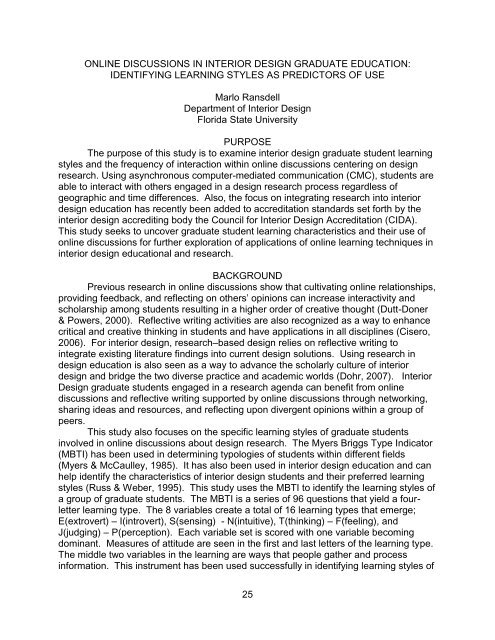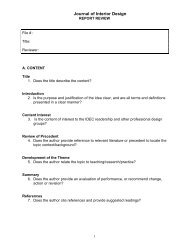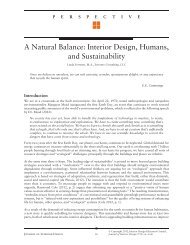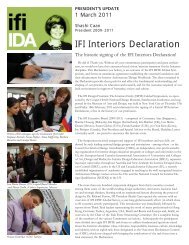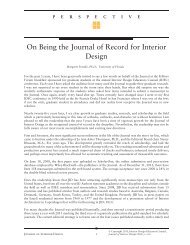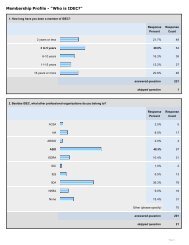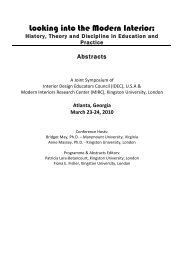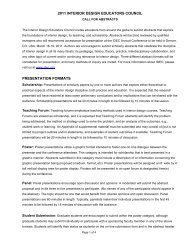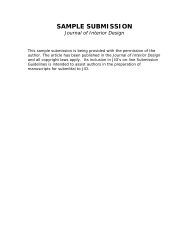South Regional IDEC Conference - Interior Design Educators Council
South Regional IDEC Conference - Interior Design Educators Council
South Regional IDEC Conference - Interior Design Educators Council
You also want an ePaper? Increase the reach of your titles
YUMPU automatically turns print PDFs into web optimized ePapers that Google loves.
ONLINE DISCUSSIONS IN INTERIOR DESIGN GRADUATE EDUCATION:<br />
IDENTIFYING LEARNING STYLES AS PREDICTORS OF USE<br />
Marlo Ransdell<br />
Department of <strong>Interior</strong> <strong>Design</strong><br />
Florida State University<br />
PURPOSE<br />
The purpose of this study is to examine interior design graduate student learning<br />
styles and the frequency of interaction within online discussions centering on design<br />
research. Using asynchronous computer-mediated communication (CMC), students are<br />
able to interact with others engaged in a design research process regardless of<br />
geographic and time differences. Also, the focus on integrating research into interior<br />
design education has recently been added to accreditation standards set forth by the<br />
interior design accrediting body the <strong>Council</strong> for <strong>Interior</strong> <strong>Design</strong> Accreditation (CIDA).<br />
This study seeks to uncover graduate student learning characteristics and their use of<br />
online discussions for further exploration of applications of online learning techniques in<br />
interior design educational and research.<br />
BACKGROUND<br />
Previous research in online discussions show that cultivating online relationships,<br />
providing feedback, and reflecting on others‘ opinions can increase interactivity and<br />
scholarship among students resulting in a higher order of creative thought (Dutt-Doner<br />
& Powers, 2000). Reflective writing activities are also recognized as a way to enhance<br />
critical and creative thinking in students and have applications in all disciplines (Cisero,<br />
2006). For interior design, research–based design relies on reflective writing to<br />
integrate existing literature findings into current design solutions. Using research in<br />
design education is also seen as a way to advance the scholarly culture of interior<br />
design and bridge the two diverse practice and academic worlds (Dohr, 2007). <strong>Interior</strong><br />
<strong>Design</strong> graduate students engaged in a research agenda can benefit from online<br />
discussions and reflective writing supported by online discussions through networking,<br />
sharing ideas and resources, and reflecting upon divergent opinions within a group of<br />
peers.<br />
This study also focuses on the specific learning styles of graduate students<br />
involved in online discussions about design research. The Myers Briggs Type Indicator<br />
(MBTI) has been used in determining typologies of students within different fields<br />
(Myers & McCaulley, 1985). It has also been used in interior design education and can<br />
help identify the characteristics of interior design students and their preferred learning<br />
styles (Russ & Weber, 1995). This study uses the MBTI to identify the learning styles of<br />
a group of graduate students. The MBTI is a series of 96 questions that yield a fourletter<br />
learning type. The 8 variables create a total of 16 learning types that emerge;<br />
E(extrovert) – I(introvert), S(sensing) - N(intuitive), T(thinking) – F(feeling), and<br />
J(judging) – P(perception). Each variable set is scored with one variable becoming<br />
dominant. Measures of attitude are seen in the first and last letters of the learning type.<br />
The middle two variables in the learning are ways that people gather and process<br />
information. This instrument has been used successfully in identifying learning styles of<br />
25


